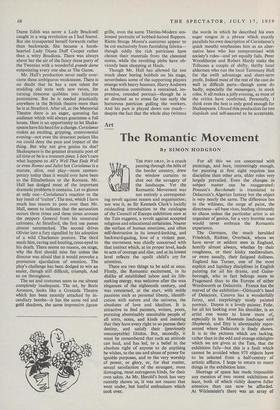Art
The Romantic Movement
By SIMON HODGSON
THE POET GRAY, in a coach passing through the hills of the border country, drew the window curtains to shut out the savagery of the landscape. Yet the Romantic Movement was not entirely a correspond- ing revolt against reason and organisation; nor was it, as Sir Kenneth Clark's lucidly misleading introduction to the catalogue of the Council of Europe exhibition now at the Tate suggests, a revolt against accepted religious and educational certainties. Nearer the surface of human emotions, and often self-destructive in its inward-looking, and backward-gazing, love of a violent past, the movement was chiefly concerned with that instinct which, at its proper level, leads to acts of courage and elan, and at its lowest level reflects the spoilt child's cry for attention.
There are two things to be said at once. Firstly, the Romantic excitement, in its dislike of established taboo and its life- seeking energy, was welcome after the wan elegances of the eighteenth century, and was concerned, at the start, with noble passions such as personal liberty, identifi- cation with nature and the universe, the absolutes of love and idealism. It is attractive to find painters, writers, poets, pursuing abominably unsuitable people of all sorts, sexes, and kinds and insisting that they have every right to so pursue their destiny, and satisfy their (previously unacceptable) libidos. But, secondly, it must be remembered that such an attitude can lead, and has led, to a belief in the absolute right of anyone to do anything he wishes, to the use and abuse of power for ignoble purposes, and to the very worship of power, or glory, or, for that matter, sexual satisfaction of the strangest, most damaging, most outrageous kinds, for their own sakes. As Mr. Herold's book has very recently shown us, it was not reason that went under, but lustful enthusiasm which took over.
For all this we are concerned with paintings, and here, interestingly enough, for painting at first sight requires less discipline than other arts, older rules very largely prevailed. Even the changes in subject matter can be exaggerated; Poussin's Bacchanale is translated to Delacroix's Algerian fantasy but the object is very nearly the same. The difference lies in the wildness, the surge of paint, the directness—all base vices, leading ultimately to chaos unless the particular artist is an organiser of genius, for a very humble man would never embrace the Romantic experience.
The Germans, the much heralded Friedrich, Richter, Overbeck, whom we have never or seldom seen in England, horrify almost always, whether by their roughness, or their kinky medievalism, or more usually, their fatigued dullness. England has Turner, one of the most explicit and lapidary disciplines in English painting for all his drama, and Gains- borough, who in fact belongs more to Fragonard than to the Europe of either Wordsworth or Delacroix. France has the marvel of the exhibition—Gericaules head of Delacroix. Canova has a wonderfully funny, and surprisingly nicely painted portrait. Doyen is a lovely painter. Fohr, for all his looking over his shoulder, is an artist one wants to know more of, especially in his Mountain landscape with Shepherds, and Etty is abominably repre- sented where Delacroix is finely shown. It is in the pictures which are lacking, rather than in the odd and strange sidelights which we are given at the Tate, that the exhibition fails—but this is a fault which cannot be avoided when 975 objects have to be selected from a half-century of artistic afflatus. I hope to return to many things in the exhibition later.
Shortage of space has made impossible any mention of two recent exhibitions at least, both of which richly deserve fuller attention than can now be afforded. At Wildenstein's there was an array of
startlingly fine paintings ranging from a Rembrandt to a Cezanne, and including, disguised in a dull subject, a lovely piece of painting by Goya. At Tooth's, Riopelle, the French Canadian painter, is showing recent canvases. The vivacity of his patterns is arresting; the ugliness of his surfaces is painful. But the real difficulty in connecting with these pictures lies in the anonymity of his personality. Here are
strongly expressed moods, translated by pattern and colour and brutal use of medium, almost betraying some recognis- able character, but always failing, in the end, to move one; that is, failing in the end to betray easily recognisable emotions; or rather, failing to convince us absolutely, that these emotions are real to him.
This is what critics call being rather contrived.'







































 Previous page
Previous page